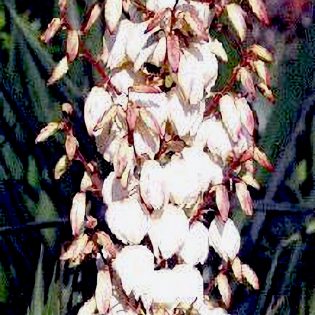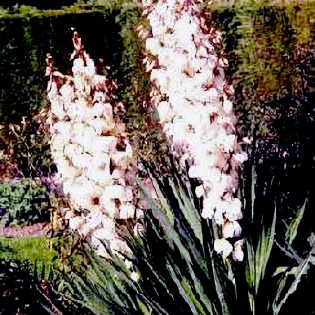By Doug Rowland, UK (11 April 2001)
![]()
The common name for this plant is Adam’s Needle. It is perhaps the most cultivated of all the hardy Yucca species in England. It can be seen in gardens just about everywhere you go.
There are about 30 species of Yucca around. They belong to the family Agavaceae and thrive principally in North America, the genus being quite wide ranging.
Our species has its natural habitat in the South-eastern States of the USA but is also widely cultivated in Northern Europe in the temperate zones.
Yucca gloriosa is a sub shrub with glaucous green, sword shaped leaves in dense rosettes, emerging from a low, slow growing, woody trunk. Leaves are around 2 feet long and 3 inches wide . Rosettes are usually erect and leaves are tipped with a single, stiff spine.
Flower spikes, sometimes to 15 feet, appear in late summer and early autumn. The flowers are broadly bell shaped and are lightly scented. The white flowers are sometimes tinged with pink in some clones, panicules being up to 4 feet long and lasting three to four weeks, late spikes occasionally being ended by an early frost.
In England, no seed capsules occur naturally due to the absence of the relevant pollinator, the Yucca Moth, for this species.
The species cultivates well in English gardens in well rained soil and eventually forms very large clumps which outgrow their allotted space and spread into the street or over the lawn so that you have difficulty in walking past your house, or cutting the lawn.
To propagate the plant, arm yourself with a pruning saw and a pair of goggles and get in there at the base and saw off the offending offsets. Often over two feet long, these rosettes can be tied up near the end for ease of transportation and handling and can be set in their new positions at any time of the year, removing the string ties when complete. The jumbo size rosettes will soon root down and never look back.
My own plant came originally from a good work friend of mine. He lived next door to a budding trombone player who practiced extensively and well into the night, seven days a week. Eventually he just had to move house and one day brought in tied up Y. gloriosa offsets in a selection of sizes, taken from the new location, for which he sought new owners. I brought one home about 20 years ago and it has flowered and offsetted many times and now the whole family has a plant each to grow. I regret I never did find out how Dudley’s new house owners fared with the trombone lessons next door.
Other suitable species for outdoor cultivation in England are Y. filamentosa, Y. flaccida and Y. recurvifolia, all of which are native to the SE USA.
Nota bene. Marina’s original Amateurs’ Digest had a Commercial Sources section where Doug and Vivi Rowland were advertised as major seed suppliers to hobbyist readers of the Digest.
Rescued from The Wayback Machine. © Copyright THE AMATEURS’ DIGEST.
![]()


